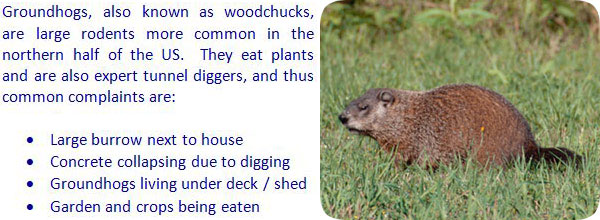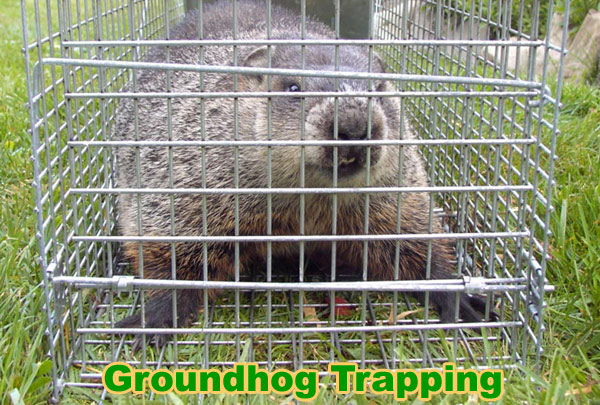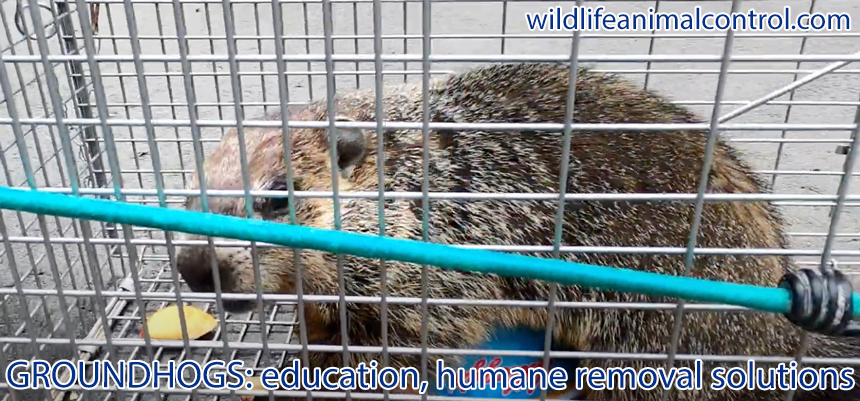- info@wildlifeanimalcontrol.com
Call us for help in your town
Wildlife Control Education
How to Get Rid of Groundhogs / Woodchucks

It is my goal to educate the public about groundhogs and other wildlife, and
provide tips for safe, effective, and responsible wildlife removal.
HUMANE HINTS: In some cases you can resolve a groundhog problem without trapping the animal - for example, you can install fencing around a garden you don't
want eaten. If you use a cage trap, be sure to set it in the shade and relocate
the groundhog as soon as possible. NEVER attempt to poison groundhogs. Unfortunately, there are no effective or registered groundhog repellents. Read below for how-to hints.
Summary of Step-By-Step Instructions:
1) Purchase large cage traps - rated raccoon size, usually about 10" x 12" x 30" or so.
2) Set traps with fresh vegetables in areas of groundhog activity. Make sure traps are scent-free and flush to the ground, and set in the shade.
3) Relocate any trapped groundhog at least 10 miles from capture site.
4) If you have groundhog living under a deck, shed, or other structure, install an exclusion barrier - steel mesh around the perimeter, and down at least 12 into the ground, with bottom of mesh sloping outward.
Need groundhog removal in your hometown? We service over 500 USA locations! Click here to hire us in your town and check prices - updated for year 2020.
How to Get Rid of Groundhogs In Garden or Yard - Groundhogs, otherwise known as woodchucks, are small rodents that are related to squirrels but live primarily in the ground instead of in trees. However, groundhogs can climb trees and they can swim as well which means that they can live in practically any environment which also means that they are harder to get rid of. Groundhogs are much smaller than squirrels and range in a variety of colors. However, you probably won’t be able to tell that you have a groundhog problem from seeing them, you will most likely know that you have a groundhog problem by the mounds of dirt that they leave behind from digging their burrows. Groundhogs live in a series of tunnels that they dig under the surface of the ground.
Usually these critters keep to themselves and do not bother anyone, but if you are a gardener you may think otherwise. Groundhogs have been known to completely destroy vegetable gardens and farmland. One of the favorite treats of groundhogs is vegetables and vegetable roots. If they burrow anywhere near or under your garden they will eat all the roots they come in contact with and your plants will just start dying.

There are many things that you can do to rid your lawn and garden of these pesky critters. Try some of these methods to effectively and humanely control the groundhog population:
- Groundhog repellents. These chemical sprays are supposed to deter or make them leave because they cannot stand the scent. These sprays do not have any sound scientific backing, but many people swear by them. You will usually spray them around the perimeter of the house or anywhere that you want to keep them out of. This works fairly well, but these sprays have known to wear off quickly. Information about groundhog repellent - analysis of types and effectiveness.
- Fencing. Building a fence around your yard or around your garden is the most effective and humane way to control your groundhog problem. Most people poison them or use traps that kill them which are not humane and do not discourage new populations of groundhogs from moving in. Make sure to build the fence deep enough (at least a foot) to keep them from burrowing under the fence. If you are on a tight budget, chicken wire or chicken mesh will do the trick as well as any high priced fencing.
- Trapping. There are two types of trapping; live trapping and lethal trapping which are both effective, but lethal trapping is not necessary as live trapping does the same thing. You can buy traps at any hardware store, lawn and garden store or pet store. They are easy to set up and safe for you and the critter. Information about groundhog trapping - analysis and methods for how to trap.
- However, there are a few tricks that you can try to make your trapping even more effective. One, wash the trap and use latex glove when you set it so that the scent of human is not on it. Two, put the trap on a flat surface so the trap does not accidentally snap before the critter is in it. Three, check the traps every day and if you are not catching anything try a different location or disguising it with branches and leaves. Click here to read about what kind of bait catches groundhogs.
- Once you have trapped the groundhog it is important to relocate it to a new home in a field, meadow or wooded area that is at least 20 miles away from your home so they don’t find their way back. You can call the local wildlife and game office to offer some suggestions on where to take them.
More in-detail how-to groundhog removal articles:
Information about how to kill a groundhog - with poison or other methods.
Information about how to keep groundhogs away - prevention techniques.
Information about how to catch a groundhog - remove one stuck in the house.

Groundhog / Woodchuck Information
Woodchuck Appearance: A woodchuck, also known as a groundhog, is a small rodent weighing approximately eight pounds and growing to be close to three feet in length. These animals appear in a variety of brown hues, with their fur divided into two distinct layers. The undercoat is generally darker and consists of thick fur, while the outer layer is longer, coarser hair made to deflect water and fine debris. Woodchucks have long bodies supported by powerful legs, and are capable of impressive digging and short bursts of speed. Scissor-like teeth aid the animal in breakdown of vegetation.Woodchuck Habitat and Behavior: Preferring open, rocky landscapes, the woodchuck is able to live in almost any region in the northern United States and Canada. Open spaces such as fields provide the groundhog with the ability to sit at the opening of a burrow and scan the landscape for any signs of danger. Burrows are usually very large, going as deep into the ground as five feet and sprawling outward for close to forty. Despite the large network of tunnels, woodchucks tend to be solitary mammals, though they will occasionally live in communities of no more than four adults. Communication through whistles informs other members of the community if danger approaches.
Duration of hibernation for woodchucks depends on the geographical location of the animal and can last from three to five months. These animals are one of the few mammals to enter into true hibernation, and it is not uncommon for their core temperatures to reach thirty-two degrees Fahrenheit. Prior to hibernation, the woodchuck will spend as much time eating as possible, building up a large fat store for the upcoming winter. Fatality during hibernation is common, and it is widely though that survival hinges on the nutritional health of the animal as well as the duration of slumber. Young woodchucks are more likely to die than woodchucks that have already been through at least two hibernation cycles.
Groundhogs mate once a year, with the male staying with the female only until she gives birth. After birth, the male will leave the burrow permanently and the female will raise the babies until they are six weeks of age. After six weeks, the offspring will be pushed out to find their own dens. Young woodchucks are extremely prone to attacks by snakes. The serpents can easily enter a burrow without fear of much resistance from an infant woodchuck.

Woodchuck Diet: Omnivorous, these animals lean toward more vegetation and less toward meat, though a hungry woodchuck will eat worms, insects, and amphibians. Crop fields are the ideal place for burrows. Nearby crops such as corn, legumes, and alfalfa are considered prime food sources for a woodchuck. The woodchuck has little need of a standing water supply; most hydration is gained through consuming vegetation.
Woodchuck Nuisance Concerns: Because of the extensive tunnel network a woodchuck can create, one of these animals living under or near a building is often cause for concern. Foundations can be compromised by a widespread burrow maze. In addition to the building concerns, woodchucks are very territorial, and will not hesitate to defend their claims from pets or people. Farmers also find the burrow systems of woodchucks intrusive. Farm equipment can take heavy damage from tunnel collapse, and acres of crops can be lost due to a woodchuck community.
Woodchuck Diseases: Depending on the area of the country, groundhogs may be considered a prime suspect for rabies. Beyond that serious disease, secondary infections through external and internal parasites are the most common concerns. Woodchucks generally harbor a large number of ticks, so tick-borne illnesses should be of some worry.
You are here to learn how to get rid of groundhogs or woodchucks in garden or yard. This site is intended to provide groundhog education and information, so that you can make an informed decision if you need to deal with a groundhog problem. This site provides many groundhog control articles and strategies, if you wish to attempt to solve the problem yourself. If you are unable to do so, which is likely with many cases of groundhog removal, please go to the home page and click the USA map, where I have wildlife removal experts listed in over 500 cites and towns, who can properly help you with your nuisance groundhog.
I have many educational articles to help you with your groundhog problem. Find out more about the The Trouble with Groundhogs . Here are some ways you can kill a groundhog in the yard, or learn about the best bait to trap a groundhog and where to relocate a trapped groundhog. Learn about the The Soundless Barrier and whether groundhog prefer living in Urban or Wild Areas. Learn more about what wildlife rehabilitators do with groundhogs and whether or not a groundhog active in the daytime means it is potentially rabid.
Learn more about groundhogs and how to take care of your groundhog problem with my educational articles. Learn what you should do if you find a nest of baby groundhogs, and some humane ways to kill a groundhog in a cage. Find out if the City or County Animal Services will help with a groundhog issue, and why groundhogs dig. Learn about teh groundhog Diet and the Diseases groundhogs carry. Read more to find out if you really Need Professional Groundhog Control Services and if a Pest Control Company will help with a groundhog issue. Learn about the Mating Habits of Groundhogs, if groundhogs make good pets, and how do you know if you have a Groundhog Digging. Learn about some of the problems caused by groundhog digging and how to get groundhogs out from Under a Shed or Porch.

















